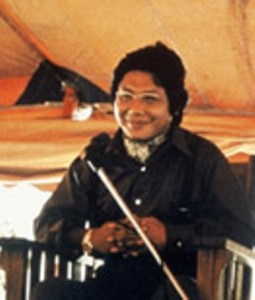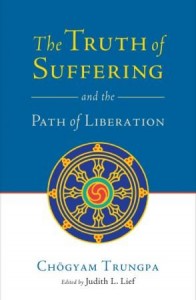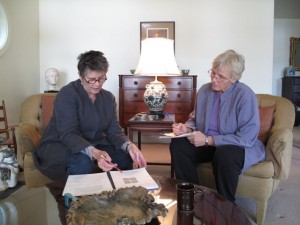Sunday
Featured Stories, Mandala ProjectsBuddhist Lists Meet Dharmic Riffs
 Jennifer Holder interviews Acharya Judy Lief about her work on the Root Text Project. This project is an effort to compile 13 years of seminary transcripts into three volumes, one for each yana, that are organized by topic. To read more about the project, click here for Rooted in the Three Yanas.
Jennifer Holder interviews Acharya Judy Lief about her work on the Root Text Project. This project is an effort to compile 13 years of seminary transcripts into three volumes, one for each yana, that are organized by topic. To read more about the project, click here for Rooted in the Three Yanas.
Who will benefit the most from the Root Text Project?
As a resource, these volumes will be particularly helpful for teachers. They can use the volumes to easily find material and deepen their understanding of real basic logic of the stages of the path. There’s so much subtlety in the understanding and presentation of meditation, what it is to be on the spiritual path, and to be a practitioner altogether. The project will also help next-generation students, who are learning from Sakyong Mipham, by giving them access to the firm foundations that his teachings are based on. Rather than asking them to read 25 volumes, it is more reasonable for them to have access to three volumes that are organized.
I’m curious about how you work with material that was slightly different or nuanced, from year to year.
It’s very difficult to work with the material because every time the Vidyadhara presented a topic, he emphasized different qualities or nuances. There are things gained and lost in a project like this. The thing that’s lost is the historic quality of the voice from year to year because each seminary has kind of a musical scale that’s unique. Whether it’s the year or the particular people who are at that seminary, there is certain charm to the tones that reflect the different moods or ambiences. And that won’t be there in the Root Text Project. But when there are subtle differences I try to weave them together so they blend. And on occasion when they are totally different, then I figure out how to deal with that by consulting with scholars and translators. Or if we’ve made changes, I footnote it. And sometimes the same topics were presented in a stronger way one year, and I’ll go with that. So it’s endless judgments, endless decisions, and I sort of cross my fingers and if I’m not sure, I try to get as good advice as I can and then go from there.
I imagine it is challenging without the author’s help to clarify.
Yes, so I do a lot of praying. But the fact is that it’s the only way it’s going to happen, so it would be great if we had the author’s help, but we don’t.
How does the Root Text Project fit in with the rest of the Vidyadhara’s books?The Root Text Project is really is a new kind of genre. Most of the books have been very evocative, based on a single seminar or a number of community talks that had a particular approach. I think of various styles of teaching as having different qualities. There are the traditional, listy teachings, which can be very academic and sometimes dry. And then there’s the others which are much more jazzy and evocative, that get to essential dharma from a unique angle, in a more artistic way. The Root Text Project really weaves the two together. I think some people will be surprised at how listy and technical a lot of material is. At the same time, there is still that quality that evokes practice, realization and also humor. Of course, there are the zingers that come up periodically when you’re like, “what?!” and it wakes you up. I’m hoping to maintain that quality.
As you point out, in his seminaries the Vidyadhara gave us the foundations. He wanted us to have the whole path, so in some way, having that kind of variety is crucial in a book that could be used for reference and clarification – and also to fuel our practice.
He makes some of the lists – which can be very dry — come alive. The way they’re described in the introduction to the Truth of Suffering and the Path of Liberation reminds me of a great jazz musician who take a theme that is very traditional and then riffs on it. By doing that, there emerges a totally new perspective on the same tune.
Do you foresee any classes based on these texts? I know teachers will use them, but I’m thinking of the way a class on Turning the Mind into an Ally has been developed.
Well I don’t know, it depends on the curriculum folks. I’m hoping that with the first little book, people will give classes on the Four Noble Truths. I did it once, actually, in Washington D.C. I used the text but because the book wasn’t out yet, nobody else had the text, except me. But it does makes a nice class.
 How do you see The Root Text Project fitting in with the Sakyong’s vision for the Way of Shambhala curriculum and path?
How do you see The Root Text Project fitting in with the Sakyong’s vision for the Way of Shambhala curriculum and path?
The Sakyong has said many times that he feels it is essential that people develop strong foundations, and then he builds on that. So this project will help to strengthen that side of things. It’s interesting timing for this to be happening, as the Sakyong continues to shape Shambhala Buddhism. The seminary transcripts provide a good, strong foundation. Our tradition is unusual in many ways, but one of the most unusual things was the extent in which the Vidyadhara taught the three yanas. A lot of Tibetan teachers never taught them and still don’t. I’ve met a lot of people in other sanghas who are studying vajrayana and aren’t familiar with the life of the Buddha much less the Four Noble Truths, Eight-fold Path, or even the point of the hinayana or mahayana. Karma, the nidanas, all that stuff which has been hammered into Shambhala vajrayana practitioners, really are the Buddhist ABCs. The Vidyadhara stressed that the seminaries be thorough because he wanted people to be teachers and he wanted teachers to know something about the tradition.
Are you still fundraising for the project? I know that if people buy The Truth of Suffering and the Path of Liberation from the Shambhala shop, all the proceeds go towards the project.
Yes, we’ll need to continue to fundraise. Although our needs are modest compared to many of the Shambala projects, we do need to continue to fundraise and we have been. While many of our big expenses have been covered, we do incur many expenses along the way and will continue to do so for the next three years.
 Click here to order a copy of The Truth of Suffering and the Path of Liberation from the Shambhala Shop.
Click here to order a copy of The Truth of Suffering and the Path of Liberation from the Shambhala Shop.
If you are interested in donating to the project, send a check to:
Chogyam Trungpa Legacy Project
Root Text Project
Ashoka Credit Union
525 Canyon Boulevard, Boulder, CO 80302

















